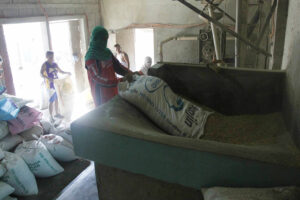By Chloe Mari A. Hufana, Reporter
REGIONAL wage boards have approved a hike in the daily minimum wages of workers in Cagayan Valley, Central Luzon and Soccsksargen, the Department of Labor and Employment (DoLE) said on Wednesday.
The move is expected to directly benefit 905,000 minimum wage earners across the three regions, starting on Oct. 17, the DoLE said in a statement.
“The new rates for workers in private establishments translate to about 7%-15% increase from the prevailing daily minimum wage rates in these three regions, and result in a comparable 7%-12% increase in wage-related benefits,” the department said.
The Regional Tripartite Wages and Productivity Board (RTWPB) in Cagayan Valley (Region II) greenlit a P30 wage increase, bringing the new minimum wage rate to P480 for non-agriculture workers and P460 for agriculture workers.
Region II is comprised of the provinces Batanes, Cagayan, Isabela, Nueva Vizcaya, and Quirino.
The wage board also approved a P500 monthly increase for domestic workers in Cagayan Valley, bringing the new monthly minimum wage to P6,000. The DoLE said this would benefit over 49,000 domestic workers, about 15% of them are on live-in arrangements, while 85% are on live-out arrangements.
The wage board in Central Luzon also granted a P50 to P66 hike in daily minimum wages, which will be given in two tranches.
For Bataan, Bulacan, Nueva Ecija, Pampanga, Tarlac and Zambales, the first tranche will take effect on Oct. 17. This will bring the minimum wage to P525 for non-agriculture workers, P485 for agriculture workers, and P515 for retail/service workers.
The second tranche will be implemented starting on April 16, 2025, bringing the daily wage to P550 for non-agriculture workers, P520 for agriculture workers, and P540 for retail/service workers.
In Aurora province, which has the lowest daily minimum wage in the region, wage hikes will also be implemented in two tranches. Starting on Oct. 17, non-agriculture workers will begin earning P475, while agriculture workers will receive P460 and those in retail/service will earn P410.
Starting on April 16, 2025, workers in Aurora will see wages go up to P500 for non-agriculture sector, P485 for agriculture sector, and P435 for retail/service sector.
For Soccsksargen, the wage board agreed to increase daily wages between P27 to P48. This covers workers in South Cotabato, Cotabato, Sultan Kudarat, Sarangani, and the lone city of General Santos.
The region’s non-agriculture workers will see wages go up by P14 on Oct. 17, and by P13 on Jan. 1, 2025, bringing the new rate to P430.
Wages for agriculture workers will go up by P14 on Oct. 17, and by P14 on Jan. 1, 2025, bringing the rate to P410.
For service workers in Soccsksargen, the wage hike will be implemented in four tranches -—by P14 on Oct. 17, by P14 on Jan. 1, 2025, by P10 on April 1, 2025, and by P10 on June 1, 2025. This will bring the new rate to P430.
The RTWPB had last issued wage orders for workers in private establishments and domestic workers in the three regions on Oct. 16, 2023.
“The new minimum wage rates are well below what is needed for formal workers and their families to subsist,” University of the Philippines Diliman School of Labor and Industrial Relations (UP SOLAIR) Assistant Professor Benjamin B. Velasco told BusinessWorld in a Facebook Messenger chat.
“The Filipino word for a job is hanapbuhay– — which perfectly expresses [the] purpose of working, that is, to earn enough for a decent life. Instead, the system of wage regionalization has created an army of working poor. People work but remain poor,” he added.
Employers Confederation of the Philippines (ECoP) Governor Arturo “Butch” C. Guerrero III said he has not received “any violent reactions so far” from their members on this round of wage hikes.
“We were really expecting P25 on the first tranche [for Central Luzon],” he told BusinessWorld in a Viber chat. “And around P30 on [the second] tranche.”
Mr. Guerrero welcomed the wage hikes for the three regions, which is less than the P35 increase in daily minimum wages for workers in the National Capital Region.
Bukluran ng Manggagawang Pilipino (BMP) Mindanao Coordinator Roldan R. Gonzales said the wage increases are still not enough.
“Each increase in workers’ wages is a significant help in facing various daily crises, even if it is not enough,” he told BusinessWorld in a Facebook Messenger chat in Filipino.
“However, we continue to call for the abolition of the RTWPB and regional/provincial rates and the reinstatement of national wage rates. We urge the passage and implementation of the P750 legislated wage increase that is currently pending in Congress,” he added.
At present, there are pending bills in both chambers of Congress seeking a legislated wage hike.
The Senate earlier this year passed a bill granting a P100 wage hike, but the House of Representatives has yet to pass a similar measure. Proposals ranging from P100 to P750 remain pending at the House.
Federation of Free Workers President Jose Sonny G. Matula echoed the call for a legislated wage increase, calling the recent round of hikes “temporary and minimal relief” for laborers.
“While these incremental wage hikes may provide a slight improvement, they are far from sufficient to address the broader issue of rising costs and economic hardship faced by Filipino workers,” he told BusinessWorld in a Viber chat.
